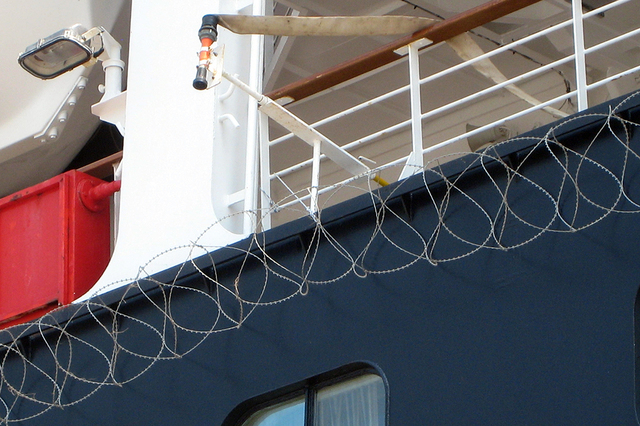Piracy precautions serious business on cruise ships

Watching Tom Hanks in “Captain Phillips,” the real-life story of Somali pirates taking over an unarmed cargo ship, probably wasn’t the smartest way to prepare for a cruise that would sail past Somalia and other pirate waters.
However, I had faith that Holland America was not about to let anything happen to the Amsterdam. Even before I left, the itinerary had been changed so that the ship would not be stopping at three ports in Egypt because of security concerns.
Despite my confidence in the cruise line, it was a little shocking, when boarding the Amsterdam in Dubai, to see the barbed wire on the third deck, the first open deck pirates could possibly board. Then there were the water hoses, pointed down toward the water line. Also noticeable were the security guards with binoculars on guard 24 hours a day.
Those were just the visible anti-pirate precautions.
Piracy protection was no joke, although when I showed Capt. Jonathan Mercer a photo of my cat wearing a pirate hat for Halloween, he did laugh.
Mercer informed passengers what steps would be taken as the ship sailed through the Arabian Sea through the Gulf of Aden into the Red Sea before heading through the Suez Canal.
When I asked for someone to interview, he set me up with security officer Dennis Superable, an anti-piracy expert who had been on the Amsterdam for 15 years, the last seven as a supervisor.
His knowledge is useful in other places as well. Pirates are not just in the Suez Canal or Somalia. The Indian Ocean has pirates, as does Indonesia and the Singapore Straits. So does the west coast of Africa.
Superable answered the question “Captain Phillips” raised. Were there guns on board the Amsterdam?
No.
He explained because Holland America ships fly under the Dutch flag, they do not have firearms. “Our weapon is our ship,” he said.
The Amsterdam is not like other ships that pirates have attempted to board, such as the Seabourn Spirit in 2005, carrying 302 passengers and crew. A BBC story at the time said at least two speedboats fired weapons and rocket-propelled grenades at the ship. However, the crew fended off the pirate attack.
Seabourn now has armed security guards because their ships don’t sail under the Dutch flag. They sail under the Bahamian flag.
That ship was more vulnerable because it was “low and slow,” Superable said.
The Amsterdam was capable of going 25 knots and actually picked up its travel pace to 20 knots in areas where there were concerns.
Holland America also has fleet inspectors, security experts who fly from the United States into ports and gather intelligence if there are concerns. That’s one reason Egypt was nixed.
The captain’s letter to passengers spelled out other invisible precautions. The ship reports to the United Kingdom Maritime Trade Organization, which coordinates all the coalition warships in the area assigned to anti-piracy operations. Warships and AWACS, a military surveillance system carried by aircraft, also monitored the cruise ship.
Long Range Acoustic Devices were “rigged, manned and ready for immediate use,” according to Mercer. LRADS, or sound cannons, are acoustic hailing devices and sonic weapons capable of sending harmful, pain-inducing tones over longer distances than normal loudspeakers.
He said if pirates did try to board, there would be an announcement, and passengers would be asked to move out of their staterooms and into corridors or interior spaces but to stay away from windows and doors and sit down “as any maneuver attempted by myself may result in heeling of the ship.”
Some people made it clear they were nervous about a potential pirate attack. One woman told me she “didn’t like it” when a pilot boarded the ship to lead it through the Suez Canal, though it was just one man boarding at the water level.
At one point, Stein Kruse, chief executive officer of the Holland America Group, joined the ship for a few days between Haifa and Athens and told passengers that the ship could tap into the intelligence resources of the FBI and the CIA.
Pirates weren’t the only concern.
Starting March 26, Saudi Arabia began airstrikes against Yemen, and there was violence in the port city of Aden. The next day, two Saudi jet fighters had mechanical problems and ejected into the Gulf of Aden. The Amsterdam would be sailing in that area a few days later.
Mercer made defensive changes along the way.
On March 30, we were entering the Red Sea less than four miles from the Yemen coast, and Capt. Mercer kicked our speed up to 23 knots in that area, before dropping back to 16 knots.
The ship stayed longer in Dubai, not for shopping but because he was concerned that the route between Dubai to Muscat, Oman, involved a very slow speed through the high-risk area for piracy. So the schedule was altered and the ship hustled to Muscat.
But there was one bit of excitement that day. A small vessel was spotted heading straight toward the Amsterdam. The officers on the bridge took note while people on the decks who noticed it rushed to take photos.
Now, they have photos of an off-course fishing ship. But no pirate photos.
Jane Ann Morrison’s column appears Thursday. Email her at Jane@reviewjournal.com.